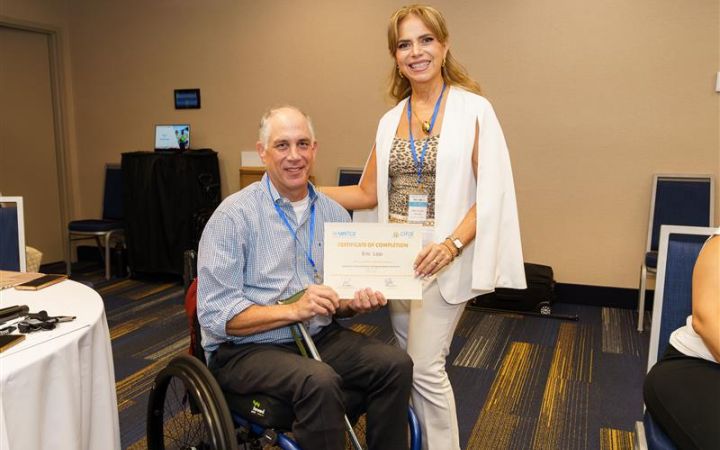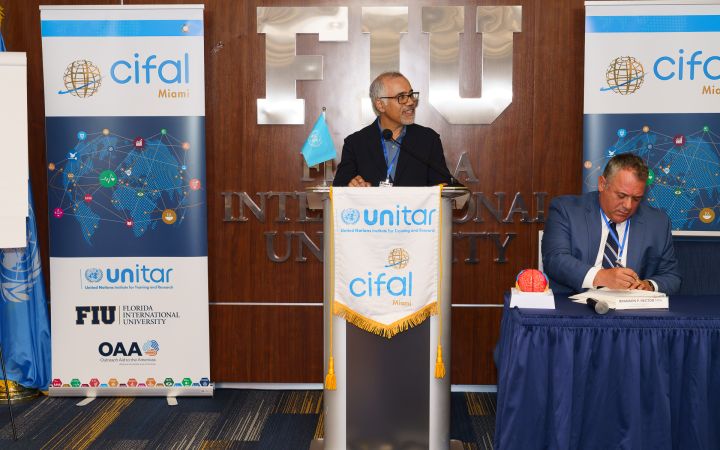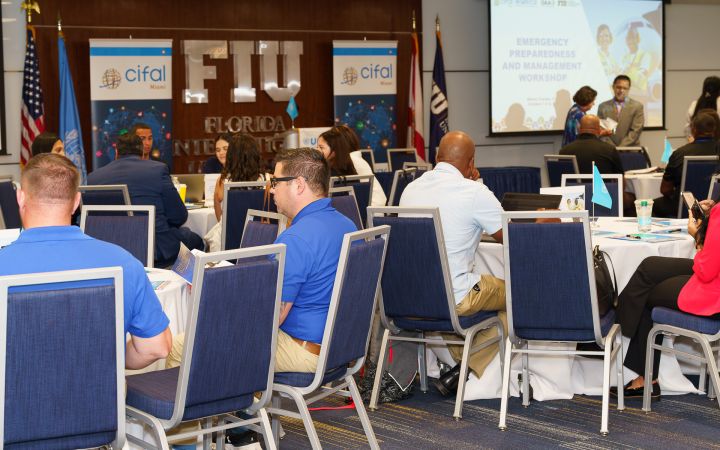The International Training Centre for Authorities and Leaders (CIFAL) Miami in close collaboration with UNITAR successfully concluded its Emergency Preparedness and Management Workshop at Florida International University (FIU) on 7-8 October 2025. The two-day intensive programme brought together a group of 35 airport professionals, emergency planners, and government officials from across the Caribbean and Southeastern United States to strengthen crisis response capabilities and operational resilience.
Hosted in partnership with Florida International University's Academy for International Disaster Preparedness (AIDP) , Miami International Airport (MIA), and Outreach Aid to the Americas (OAA) , the workshop addressed critical challenges facing airports in one of the world's most disaster-prone regions. The event emphasized practical, scenario-based training tailored to regional threats including hurricanes, flooding, and complex multi-agency responses.
The workshop's timing proved particularly relevant as the Caribbean and Southeastern United States continue recovering from recent weather events while preparing for increasingly intense hurricane seasons driven by climate change.
FIU Provost Dr. Elizabeth M. Béjar opened the workshop by emphasizing the university's commitment to regional preparedness: "With over 56,000 students and extensive research capabilities, FIU stands ready to support our communities in building resilience against the disasters that regularly threaten our region."
Multi-Agency Coordination in Focus
A central theme throughout the workshop was the critical importance of stakeholder coordination during emergencies. Pete Gomez, Director of Miami-Dade County's Department of Emergency Management, shared insights from his 40 years of public safety experience, including responses to major disasters across South Florida. His presentation on the county's Urban Area Security Initiative (UASI) demonstrated how federal funding supports regional homeland security capabilities.
The workshop featured a comprehensive panel on stakeholder coordination bringing together representatives from U.S. Customs and Border Protection (USCBP) , Transportation Security Administration (TSA), Atlanta Police Department (APD) , and the Centers for Disease Control and Prevention (CDC) . This multi-agency discussion revealed the complexity of coordinating unified emergency responses across jurisdictional boundaries.
Stephanie Mendoza Berríos, Airport Director of Emergency Management at Hartsfield-Jackson Atlanta International Airport (ATL) , presented their innovative approach to developing an Integrated Operations Center (IOC). Her vision for centralizing coordination across all airport functions, from airside operations to ground transportation, offered a model for seamless incident escalation and resolution.
The workshop emphasized hands-on learning through tabletop exercises facilitated by Robert Jorge of FIU's Academy for International Disaster Preparedness and Patricia Ryan, Director of Training at CIFAL Miami. Participants worked through three distinct emergency scenarios, developing response strategies that could be immediately implemented at their home airports.
A unique highlight was the exclusive tour of Miami International Airport's operations, providing vetted participants with behind-the-scenes access to MIA's emergency management infrastructure. Ralph Cutié, CEO and Airport Director of MIA, welcomed participants personally, noting the airport's transformative $9 billion capital improvement program that integrates resilience planning throughout all upgrades.
Inclusive Emergency Planning
Eric Lipp, President of Open Doors Organization , and Matthew Shaw from the Rick Hansen Foundation led critical sessions on emergency planning for travellers with disabilities. Their presentations challenged participants to consider accessibility not as an afterthought but as a fundamental component of emergency preparedness.
"Life with a disability is about finding ways to live ingeniously," Shaw explained, sharing his perspective as someone with a degenerative deafblind condition. "Emergency planning must embrace this ingenuity to create truly inclusive response protocols."
Continuity of Operations
The second day focused heavily on ensuring operational continuity during and after disasters. Branson P. Rector, a Strategic Logistics and Disaster Response Consultant, drew from his extensive Department of Defense experience to outline supply chain strategies that maintain critical resource flows during emergencies.
Dr. Ali Asgary, Director of CIFAL York and a disaster management professor at York University, presented advanced modelling and simulation techniques for airport emergency response. His work with AI, virtual reality, and drone technologies demonstrated how emerging tools can enhance traditional emergency management approaches.
Moving Forward
Maricarmen Estrada, Director of CIFAL Miami, highlighted the workshop's role in strengthening regional preparedness networks: "Through our Community and Ports Disaster Preparedness and Resiliency Program, we've now trained over 1,500 individuals across 20+ countries. Each workshop builds connections that prove invaluable when disasters strike."
The workshop's diverse participation, including representatives from airports ranging from major international hubs to smaller regional facilities, fostered rich exchanges of experiences and solutions. Chip Geiger from Chicago Rockford International Airport noted how strategies developed for large airports could be adapted for smaller operations with limited resources.
Estrella Merlos, Deputy Head of the CIFAL Global Network at UNITAR, concluded: "Emergency preparedness is not achieved through single events but through continuous learning, adaptation, and collaboration. This workshop represents one crucial step in building a more resilient airport infrastructure across the Americas."
As climate change intensifies weather-related threats and global connectivity increases the potential for cascading failures, such capacity-building initiatives become ever more critical for maintaining safe, resilient airport operations.
With hurricane season approaching and memories of recent disasters still fresh, participants returned to their airports equipped not just with practical knowledge but with a strengthened network of colleagues ready to provide mutual support when the next crisis emerges. In a region where disasters are not a matter of if but when, this preparation could prove invaluable for protecting lives, maintaining operations, and supporting community recovery.









